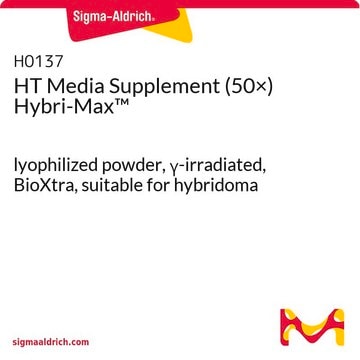06563
Methotrexate hydrate
≥99.0% (sum of enantiomers, HPLC)
Synonym(s):
4-Amino-10-methylfolic acid hydrate, L-4-Amino-N10-methylpteroylglutamic acid hydrate, L-Amethopterin hydrate, Antifolan hydrate, MTX hydrate, Methylaminopterin hydrate
About This Item
Recommended Products
biological source
synthetic
Assay
≥99.0% (sum of enantiomers, HPLC)
form
powder or crystals
optical activity
[α]/D +21.0±2.0°
impurities
≤0.1% sulfated ash
mp
185-204 °C
solubility
water: insoluble
storage temp.
−20°C
SMILES string
[H]O[H].CN(Cc1cnc2nc(N)nc(N)c2n1)c3ccc(cc3)C(=O)N[C@@H](CCC(O)=O)C(O)=O
InChI
1S/C20H22N8O5.H2O/c1-28(9-11-8-23-17-15(24-11)16(21)26-20(22)27-17)12-4-2-10(3-5-12)18(31)25-13(19(32)33)6-7-14(29)30;/h2-5,8,13H,6-7,9H2,1H3,(H,25,31)(H,29,30)(H,32,33)(H4,21,22,23,26,27);1H2/t13-;/m0./s1
InChI key
FPJYMUQSRFJSEW-ZOWNYOTGSA-N
Gene Information
human ... DHFR(1719)
Looking for similar products? Visit Product Comparison Guide
General description
Application
Other Notes
Signal Word
Danger
Hazard Statements
Precautionary Statements
Hazard Classifications
Acute Tox. 3 Oral - Muta. 2 - Repr. 1B - STOT RE 1
Target Organs
Liver,Bone marrow
Storage Class Code
6.1C - Combustible acute toxic Cat.3 / toxic compounds or compounds which causing chronic effects
WGK
WGK 3
Flash Point(F)
Not applicable
Flash Point(C)
Not applicable
Personal Protective Equipment
Certificates of Analysis (COA)
Search for Certificates of Analysis (COA) by entering the products Lot/Batch Number. Lot and Batch Numbers can be found on a product’s label following the words ‘Lot’ or ‘Batch’.
Already Own This Product?
Find documentation for the products that you have recently purchased in the Document Library.
Customers Also Viewed
Our team of scientists has experience in all areas of research including Life Science, Material Science, Chemical Synthesis, Chromatography, Analytical and many others.
Contact Technical Service












